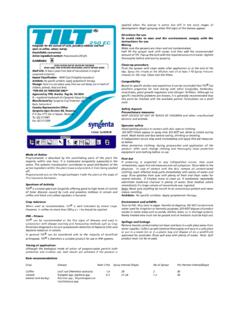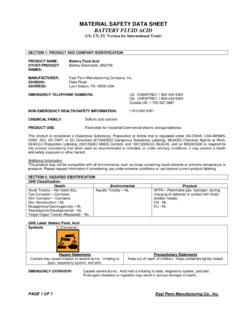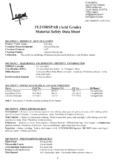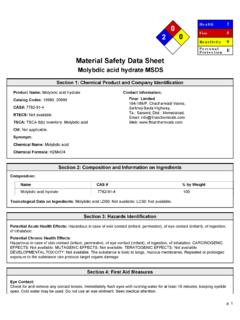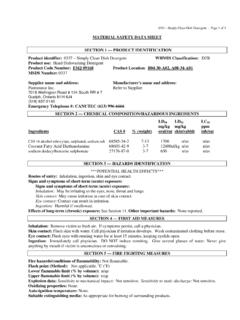Transcription of Material Safety Data Sheet NITRIC ACID - Triachem
1 Seastar Chemicals Inc MSDS NITRIC acid Page 1 of 4 Material Safety data Sheet NITRIC acid Print Date: March 2007 SECTION 1 Chemical Product and Company Identification MSDS Name: NITRIC acid MSDS Preparation Date: 02-2007, Supersedes, 02-2004, 02-2001, 02-98 Synonyms: Acide nitrique, Aqua fortis, Azotic acid , Hydrogen nitrate Product numbers: BA-01-0250, BA-01-0500, BA-01-1000, BA-01-2000, IQ-01-0500, IQ-01-0500S, IQ-01-1000, IQ-01-1000R, IQ-01-2000, IQ-01-2000T, IQ-01-2500, IQ-01-2500-S, IQ-01-2500-6, IQ-01-2500-PVC, IQ-01-25SK, IQ-01-25 SKS, IQ-01-25SK6, IQ-01-200L, CP01-2000F410, CP01-2000F620, CP01-020 LPE1N, OVERFLOW-01, OVF-01-TOTE Canadian TDG Classification: 8 PKG Gr II Formula: HNO3 PIN (UN# / NA#): UN2031 Molecular Wt: WHMIS Classification: Class C (Oxidizing Material ), Class D Division 1 Subcategory A (Materials Causing Immediate and Serious Toxic Effects), Class E (Corrosive Material ).
2 Supplier: Seastar Chemicals Inc, 10005 McDonald Park Road, Sidney, BC V8L 5Y2 CANADA Tel: (250) 655-5880, Fax: (250) 655-5888 CANUTEC (CAN): (613)-996-6666 SECTION 2 Composition/Information on Ingredients CAS # Chemical Name Percent EINECS/ELINCS TLV Hazard 7697-37-2 NITRIC acid 60-71% 231-714-2 (TWA) 2 ppm* Corrosive 7732-18-5 Water Balance 231-791-2 None None Hazard Symbols: O C Risk Phrases: 35 8 SECTION 3 Hazards Identification EMERGENCY OVERVIEW Appearance: clear to yellow. Danger! Corrosive. Strong oxidizer. Contact with other Material may cause a fire.
3 Causes eye and skin burns. Causes digestive and respiratory tract burns. Target Organs: None. Potential Health Effects Primary Route(s) of Entry: Skin contact. Eye contact. Inhalation and Ingestion. Effects of Acute Exposure: May be fatal by ingestion, inhalation or skin absorption. Corrosive. LDLo: ORAN-human 430 mg/kg. LD50/LC50: CAS# 7697-37-2: Inhalation, rat: LC50 = 67 ppm (NO2)/4H. CAS# 7732-18-5: Oral, rat: LD50 = >90 mL/kg. Inhalation, rate: LC50 = 1276 ppm/1H. Eyes: Causes severe eye burns and loss of vision. May cause permanent damage. Skin: May cause severe skin irritation. Causes skin burns. May cause deep, penetrating ulcers of the skin. Ingestion: Causes gastrointestinal tract burns. May cause perforation of the digestive tract.
4 Burns in mouth, pharynx and gastrointestinal tract. Vomiting, nausea, diarrhea, abdominal pain, kidney damage and death. Inhalation: May be fatal if inhaled. Effects may be delayed. May cause irritation of the respiratory tract with burning pain in the nose and throat, coughing, wheezing, shortness of breath and pulmonary edema. Chemical pneumonitis, bronchitis, and possible death. Effects of Chronic Exposure: Repeated inhalation may cause chronic bronchitis. Repeated exposure may cause erosion of teeth. May cause erosion of the teeth, lesions of the skin, bronchial irritation, coughing, pneumonia and lung damage. To the best of our knowledge the chronic toxicity of this substance has not been fully investigated. SECTION 4 First Aid Measures Eyes: Flush eyes with plenty of water for at least 15 minutes, holding lids apart to ensure flushing of the entire surface.
5 Get medical aid immediately. Do NOT allow victim to rub or keep eyes closed. Skin: Get medical aid immediately. Immediately flush skin with copious quantities water for at least 15 minutes. Remove contaminated clothing and shoes. Wash clothing before reuse. Call a physician. Seastar Chemicals Inc MSDS NITRIC acid Page 2 of 4 Ingestion: Do NOT induce vomiting. If victim is conscious and alert, give 2-4 cupfuls of milk or water. Get medical aid immediately. Call a physician. Never give anything by mouth to an unconscious person. Inhalation: Remove patient from exposure to fresh air immediately. If not breathing, give artificial respiration. If breathing is difficult, give oxygen. Get medical aid. Call a physician. Notes to Physician: Treat symptomatically and supportively.
6 SECTION 5 Fire Fighting Measures General Information: As in any fire, wear a self-contained breathing apparatus in pressure-demand, MSHA/NIOSH (approved or equivalent), and full protective gear. Contact with combustible materials may cause a fire. Use water spray to keep fire-exposed containers cool. Substance is non-combustible. Special Fire and Explosion Hazards: Oxidizing Material contributes to combustion of other materials. Emits toxic fumes under fire conditions. Contact with other materials may cause fire and/or explosion. Extinguishing Media: Substance is non-combustible; use agent most appropriate to extinguish surrounding fire. Water spray. Auto-ignition Temperature: N/ap.
7 Flash Point: None. NFPA Rating: Health 4; Flammability 0; Instability 1; Other OXIDIZING Material Explosion Limits: Lower: Not available. Upper: Not available. SECTION 6 Accidental Release Measures General Information: Use proper personal protective equipment as indicated in Section 8. Spills/Leaks: Absorb spill with inert Material ( , dry sand or earth), then place into a chemical waste container. Neutralize spill with sodium bicarbonate. A vapor suppressing foam may be used to reduce vapors. Steps to be taken in case Material is released or spilled: Wear self-contained breathing apparatus, rubber boots and heavy rubber gloves. Add lime. Mix carefully with water to form a slurry place in a suitable container and send for disposal.
8 Ventilate area and wash spill site after Material pick-up is complete. Waste disposal method: According to all applicable regulations. Avoid run-off. SECTION 7 Handling and Storage Handling: Wash thoroughly after handling. Remove contaminated clothing and wash before re-use. Use with adequate ventilation. Do not get on skin or in eyes. Do not ingest or inhale. Storage: Store in a cool, dry, well-ventilated area away from incompatible substances, heated areas, sparks and flame. Do not store in metal or glass containers. Do not store in direct sunlight. Do not store near organic substances. Keep tightly closed. Empty container may contain hazardous residue. Do not add any other Material to the container.
9 Do not wash down the drain. Do not get in eyes, on skin, or on clothing. Wash well after use. In accordance with good storage and handling practices. Do not allow smoking or food consumption while handling. Storage Code: White. SECTION 8 Exposure Control/Personal Protection Engineering Controls: Use adequate general or local exhaust ventilation to keep airborne concentrations below the permissible exposure limits Exposure Limits: Chemical Name ACGH NIOSH OSHA NITRIC acid 2 ppm TWA; mg/m3 TWA; 4 ppm STEL; 10 mg/m3 STEL 2 ppm TWA; 5 mg/m3 TWA; 4 ppm STEL; 10 mg/m3 STEL 2 ppm TWA; 5 mg/m3 TWA. Water None listed. None listed. None listed. OSHA Vacated PELs NITRIC acid : 2 ppm TWA; 5 mg/m3 TWA.
10 NITRIC acid : 2 ppm TWA; 5 mg/m3 TWA Personal Protective Equipment Eyes: Wear appropriate protective eyeglasses or chemical Safety goggles as described by OSHA s eye and face protection regulations in 29 CFR Wear face shield. Skin: Wear appropriate protective neoprene gloves to prevent skin exposure. Wear acid -resistant PVC or neoprene jacket, trousers and boots sufficient to protect skin. Clothing: Wear appropriate protective clothing to prevent skin exposure. Seastar Chemicals Inc MSDS NITRIC acid Page 3 of 4 Respiratory Protection: Wear appropriate OSHA/MSHA approved chemical cartridge respirator. Regulations found in 29 CFR If more than TLV, do not breathe vapour. Wear self-contained breathing apparatus.




